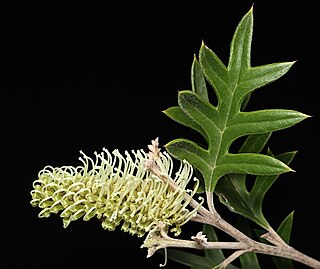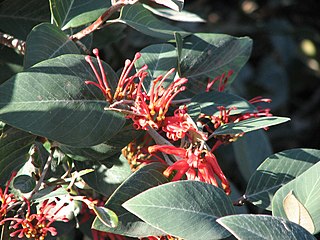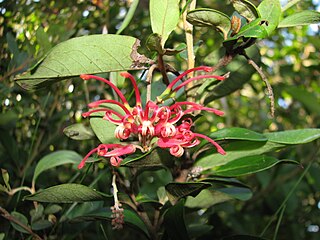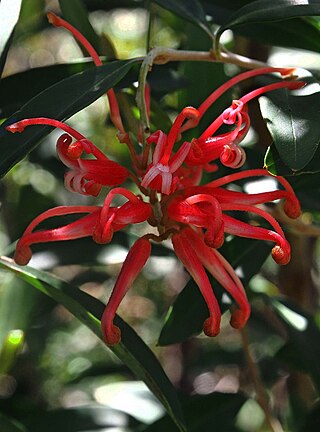
Hakea is a genus of about 150 species of plants in the Family Proteaceae, endemic to Australia. They are shrubs or small trees with leaves that are sometimes flat, otherwise circular in cross section in which case they are sometimes divided. The flowers are usually arranged in groups in leaf axils and resemble those of other genera, especially Grevillea. Hakeas have woody fruit which distinguishes them from grevilleas which have non-woody fruit which release the seeds as they mature. Hakeas are found in every state of Australia with the highest species diversity being found in the south west of Western Australia.

Grevillea microstegia, commonly known as Mount Cassell grevillea, is a species of flowering plant in the family Proteaceae and is endemic to Victoria in Australia. It is a prostrate to low-lying or straggling shrub with deeply divided leaves, the end lobes triangular, and toothbrush-shaped clusters of reddish-brown flowers with a red style.

Grevillea obtecta, commonly known as Fryerstown grevillea, Elphinstone grevillea or Taradale grevillea, is a species of flowering plant in the family Proteaceae and is endemic to Victoria in Australia. It is a prostrate, clumping or straggling shrub with pinnatifid, pinnatipartite or toothed leaves, and toothbrush-like clusters of light green to yellowish and purplish to black flowers with a dull yellow to pink style.
Banksia croajingolensis, commonly known as the Gippsland banksia, is a species of small shrub that is endemic to a small area in Victoria, Australia. It is known from fewer than 500 plants growing along a single drainage line in the Croajingolong National Park.

Grevillea celata, commonly known as Nowa Nowa grevillea or Colquhoun grevillea, is a species of flowering plant in the family Proteaceae and is endemic to a restricted part of Victoria in Australia. It is an erect and open to low, dense shrub with oblong, broadly elliptic or linear leaves, and red and yellow, or red, white and apricot-coloured, sometimes all yellow flowers.

Grevillea willisii, commonly known as Omeo grevillea or rock grevillea, is species of flowering plant in the family Proteaceae, and is endemic to the eastern highlands of Victoria, Australia. It is a spreading to erect shrub with pinnatipartite leaves, the end lobes broadly triangular to oblong and sometimes sharply pointed, and dense clusters of greenish-white to fawn-coloured flowers with a white to cream-coloured style.

Grevillea burrowa, commonly known as Burrowa grevillea, is a species of flowering plant in the family Proteaceae and is endemic to a restricted area of Victoria, Australia. It is a spreading shrub with oblong to egg-shaped leaves, and clusters of reddish-pink flowers.

Grevillea polychroma , commonly known as Tullach Ard grevillea, is a species of flowering plant in the family Proteaceae and is endemic to eastern Victoria. It is a spreading to erect shrub with densely hairy branchlets, egg-shaped leaves, the narrower end towards the base, and down-turned clusters of hairy, cream-coloured, pale yellow or pink to red flowers.

Grevillea miqueliana is a species of flowering plant in the family Proteaceae and is endemic to Victoria in Australia. It is an erect to spreading shrub with elliptic to egg-shaped leaves and clusters of red and orange or yellow flowers.

Grevillea monslacana, commonly known as Lake Mountain grevillea, is a species of flowering plant in the family Proteaceae and is endemic to mountainous areas of eastern Victoria in Australia. It is a spreading to erect shrub with narrowly egg-shaped leaves and clusters of pink to reddish pink flowers.

Grevillea callichlaena, commonly known as Mt. Benambra grevillea, is a species of flowering plant in the family Proteaceae and is endemic to a restricted part of Victoria in Australia. It is a spreading shrub with elliptic, egg-shaped or broadly lance-shaped leaves, and uniformly red flowers.

Grevillea bemboka is a species of flowering plant in the family Proteaceae and is endemic to a restricted area of far south-eastern New South Wales. It is a spreading to erect shrub with hairy branchlets, egg-shaped to elliptic leaves and red or reddish-pink flowers.

Hakea pulvinifera is a small, prickly shrub in the family Proteaceae, found only on one rocky hillside near Gunnedah in New South Wales, Australia. The species was first described in 1962, believed extinct in 1971 and rediscovered in 1988. The entire species may be of only one genetically unique individual.

Hakea eriantha, commonly known as tree hakea, is a shrub or small tree endemic to the east coast of Australia. It has white flowers on a woolly stem in leaf axils, long narrow leaves with reddish new growth. Found growing at higher altitudes in moist or sclerophyll Eucalyptus woodland.

Hakea aenigma, commonly known as the enigma hakea, is a shrub in the family Proteaceae native to South Australia. Only one of two Hakea species totally reliant on suckering to reproduce therefore have "reached evolutionary dead-ends".

Hakea repullulans, commonly known as the furze hakea, is a flowering plant in the family Proteaceae found in Victoria and South Australia.
Acacia infecunda, also known as famine wattle, is a shrub belonging to the genus Acacia and the subgenus Phyllodineae that is native to parts of south eastern Australia.
Eucalyptus forresterae, commonly known as brumby sallee, is a species of "whipstick" mallee that is endemic to a restricted area in Victoria. It has smooth greenish to whitish bark, glossy green, lance-shaped to narrow egg-shaped adult leaves, flower buds in groups of between eleven and twenty one, white flowers and conical or shortened hemispherical fruit.
Eucalyptus ornans, commonly known as Avon peppermint, is a species of mallee that is endemic to a restricted area in Victoria. It has smooth whitish to grey bark, slightly glossy, bluish green, lance-shaped adult leaves, flower buds in groups of between seventeen and twenty one, white flowers and shortened hemispherical fruit.
Eucalyptus phoenix, commonly known as brumby mallee-gum, is a species of mallee that is endemic to a restricted area in Victoria, Australia. It has smooth white to greyish bark, glossy green, lance-shaped adult leaves, flower buds in groups of between five and eleven, white flowers and hemispherical fruit.














